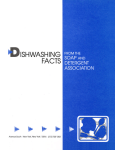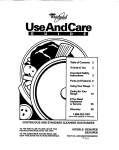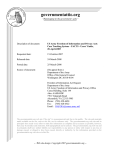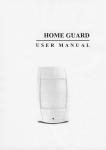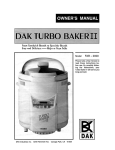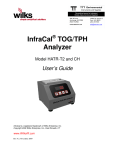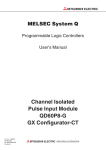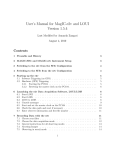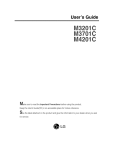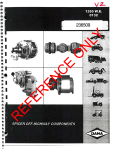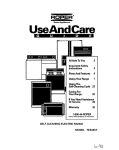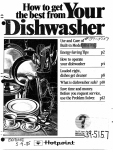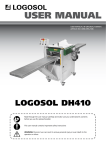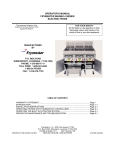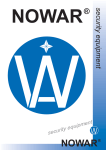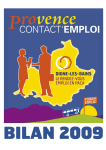Download Hand Dishwashing Products
Transcript
HAND DISHWASHING PRODUCTS Dishwashing is probably subject to more variables than any other household clean-up job. Consequently, there is a wide choice of products formulated to do the job effectively, easily,and efficientlyIn theory at least, any detergent or soap can be used for hand dishwashing, except an automatic dishwasher detergent. However.soap has become almost extinct as a dishwashing product and many all purpose or laundry detergents are not very acceptable. These laundry detergents. particularly if a low or no phosphate formula, may leave spots and streaks, may not completely dissolve if a granular type, or may discolor certain metals with soaking. A well formulated, all purpose detergent may be the choice for dishes in some economy-minded homes, but for most, a light duty liquid hand dishwashing detergent is the best choice. Liquid Hand Dishwashing Detergents Regardless of brand, certain characteristics are important in a hand dishwashing liquid: lasting suds, effective cleaning performance, mildness to hands, safety for dishes and other washables, storage stability, pleasant fragrance and appearance, convenient packagingand dispensing.In formulating a product to meet these criteria, manufacturers, in general, use certain basic ingredients. Ingredients Surfactants or surface active agents are the primary ingredients in a liquid hand dishwashing detergent. Often a combhation is used to produce a high, stable suds level, good greasecutting capability and soil suspension, and mildness in water of varying degrees of hardness. All surfactants in these detergents are biodegradable. Stability and Dispensing Aids are added to keep the product homogeneous under varying storage conditions, and to provide desirable dispensing characteristics. Alcohols, hydrotropes. and salts are often used. Fragrance and Color Additives are what give a product its "personaliw, and are important though present in extremely small amounts. Mildness Additives may include certain oils and emollients, certain protein compounds, or other neutralizing or beneficial ingredients. Preservativesare added, if needed, in small quantitiesto help prevent any microbiological growth in the product which could cause color or odor change, poor performance, and separotion of the ingredients. Lemon Juice may be added to help reduce the effort needed to remove some baked-on protein-containing soils from dishes and cookware, especially when dishwashing solutions are used in soaking. Performance Factors Hand dishwashing liquids are relatively easy for consumers to compare. Users can experiment by trying various brands and deciding which product feaures are important to them . . . performance, price, sudsing, fragrance, and Yeel': or perhaps the packaging. Usage is often based on the amount it takes to produce a rich, thick layer of suds. Though detergents are not as affected by water hardness as soap is, some additional product may be necessary in very hard water.An important difference inthe quantityof liquid hand dishwashing detergent required is the concentration of the surfactants vs. water in a product.More concentrated products are more efficient and may be more economical to use than the more dilute ones. Other Cleaners and Cleansers Metal Cleaners, paste, powdered, and liquid, are formulated to remove oxidation, tarnish, spots and stains, heat tinting, and light scratches from a variety of metals or from a specific metal such as silver or copper. They combine both chemical action and abrasion. Usually, the abrasive is fine to produce a polishing effect without scratching. Sink Cle'ansers,powdered or a liquid slurry contain medium to hard abrasive particles, some detergent, and usually chlorine bleach for stain removal and disinfection of surfaces. A few cleansers contain oxalic acid in place of bleach and are made spe- cifically for removal of rust stains. While cleansersare used primarilyfor scouring sinks and other surfaces, they are useful occasionally when handwashing cookware, particularly glass or glass-ceramic types. Disposal of Dishwashing Products Just as you exercise care in the manner in which you use and store other household cleaning products, you should properly dispose of empty dishwasher detergent containers or small amounts of leftover products by following some simple procedures. Most dishwashing products can be sent to municipal waste sites through normal garbage pick-up. Check the container for special instructions for disposal, then: *Always resecure the cap, especially if it is a child resistant one. This will not only prevent a mess in your garbage, but will protect children, pets, and garbage handlers and prevent accidental mixtures which may be hazardous. Discard the product into a container that is not easily accessible to children or pets (for example, into an ,outside garbage container secured with a lid). Special considerations: Always read and follow label instructions for use. Always check labels for any special disposal procedures and follow instructions. NNER reuse an empty dishwashing product container for another purpose. The label instructions and precautions for one product may be dangerous to someone trying to use those instructionsfor a different product. Get the most for your money- USE THE PRODUCT UP! If you find you cannot use all of the product you purchased, give it to a friend, but make sure the label with precautions is still legible. READ ALL LABELS THOROUGHLY AND USE PRODUCTS ONLY FOR INTENDED PURPOSES AND AS DIRECTED. HAND DISHWASHING PROBLEMS, CAUSES AND SOLUTIONS Roblems causes solutions Knife or fork drawn across the surface of Scour gentfy with baking soda mild abrasive cleanser or p l d c mesh pad. ~~ Gray or metal marks on dinnerware. some typesof dinnerware,generally the stronger. harder ceramic materials. A spoon used to stir in a stoneware cup. Same as above. Wash water temperature too low Increase water temperature and rinse thoroughly in hot water. Insufficientamount of detergent. Increase amount of detergent. Cooking at too high a temperature or too long a time. Bring a solution of water and liquid hand dishwashing detergent to a boil in the pan, simmer until soil loosens.Or,scrubwith bakingsoda sprinkledon a plastic scouring pad rinse and dry. Baked-on food in casseroles, other Cooking certain types of food such as bakeware of glass or glass-ceramic those containing cheese, gravies. eggs or pie fillings. material. Soak in a solutionof liquid handdishwashingdetergent andwater to loosensoil. Do not use any automatic dishwasher detergent product for handwushing,For scouring, use baking soda, an abrasive cleanser.or a specially manufactured product. Do not use metal scouring pads as they may scratch the surface. Coffee, tea stains on plastic or china Cups not rinsed and washed soon after cups. using. Use a special cleaner made for coffee pots and cups, or a solution of 1tablespoon (I5ml) liquid or powderedchlorine bleach in 1quart (0.95L) of water. Certain oxygen bleaches can be used. Follow label directions. - Spots and film on glassware. Bumed-on-foodin pans. Another method is to wash cups in a solution of 3 tablespoons (45ml) baking soda to 1 quart (0.95L) of hot water or shake baking soda into a damp cloth or sponge, rub surface until clean, rinse and dry Avoid the use of an abrasive cleanser which may abrade the surface and make the cups more subject to stains. Darkened aluminum. Exposure to certain minerals and alkalies in some foods and water. Boila solutionof 2-3 tablespoons (30-45ml)of cream of tartar.lemonjuice or vinegar to 1quart (0.95L)of water in the utensilfor 5-10 minutes.Then lightlyscour with a steel wool soap pad. Cooking an acid food such as tomatoes will also remove the stains and will not affect the food. Clean with a metal cleaning product recommended for use on aluminum. Follow package directions. ~ Staining of nonstick cookware. _ _ Minerals in water, baked-on fat food stains or the use of excessive heat. The Soap and Detergent Association 475 Pork Avenue South New York New York 10016 ~~~ ~ ~~ ~ Use any one of the following solutions: To 1qt. (0.95L) of water. add '/4 cup (60ml) coffee pot cleaner. Or to 1cup (240ml) of water, add 3 tablespoons (45ml) of oxygen bleach. Let the solution simmer in the stained pan for 15-20minutes.Wash the pan thoroughly rinse and dry. Then recondfflon the pan with cooking oil or shortening before using. To prevent staining use the lowat heot that will do the job. AUTOMATIC DISHWASHING PROCEDURES An automatic dishwasher produces clean dishes, keepsthe kitchenfree of clutter before and after meals, generally uses less water. reduces breakage, helps control germs, and frees time for other activities. Automatic dishwashersvary from brandto brand, model to model, but all clean by the action of hot detergent solution that is Circulated by spray arms and towers. Water temperature, detergent concentration. and proper loading of the racks are all importantto good results. Check Water Temperature Be sure water temperature is at least 130 F (54.4 C) in the dishwasher, To help provide proper temperature for dishwashing,the water heater should be set at mid-rangeor 140 F (60 C). A dishwasher is connected to the hot water line onb and it may be wise to run the hot water tap at the kitchen sink for a few minutes to clear the line of cool water before turning on the dishwasher. The sink is also a convenient place to measure the hot water temperature. Some dishwashers heat water right in the tub to compensate for low temperature hot water supplies. O O O O Scraping and Prerinsing Prerlnsing dishes and glassware should not be necessary. An automatic dishwasher detergent and a properly installed and operating dishwasher of reasonably current vintage will do a thoroughjob with just a scraping off of large food particles.If dishes-areto be loaded into the dishwasher and washed later.the 'rinse-hold' cycle can be used; but experiencemay show that even this is not necessary.Extra heavily soiled cookware may need a rinse, soak or a prewash. loading the Dishwasher Variations in dishwashers make it important to study directions and diagrams in the user's manual. The most important factor is the positioning of the dishes and utensils in relation to the wash action. Be sure to place the heavily soiledside of each itemfacing the source of the water spray at the center of the tub. Don't let large items shield small ones. Keep cups, bowls, and glasses with bottoms up. Flatware should be loaded according to the manufacturer's instructions. Do not crowd or nest spoons together so water can reach the soiled areas. Place sharp items with pointsdown for safety reasons. Be sure more delicate items are firmly supported by the rack so they won't topple and possibly break or chip. Experience and results will show how closely together dishes can be placed and how fully the racks can be loaded for satisfactory results. Do not put stainless steel and silver flatware in the same silverware basket compartment. Direct contact between these metalscan cause permanent damage to the silver. Adding Detergent Use only a product made specifically for automatic dishwashers (see "Automatic Dishwasher ProductsT. Any other type will cause oversudsing and possible damage to the appliance. Use the amount recommended on the detergent container and in the uset's manual, adjusting it to the amount of soil, water hardness, and load size. Some detergent dispensers have lines to indicate the amount of detergent to add. In hard water, it is particularly important to use detergent as recommended by the dishwasher manufacturer. The following chart defines the levels of water hardness generally accepted as 'soft", 'hard", etc, and can serve as a guide as to whether the manufacturer's use recommendations should be increased or decreased. son Mod Hard Hard Herv Hard Grains per gcllb 0.0-35 3.6-7.0 7.1-10.5 IO& R m per million w milligrams 0.060 61-120 per liter Source: US Gedogiil Survey 121-180 More thon iao Add the detergent (granular or liquid) to the dispenser cup(s] after the dishwasher is loadedand is readyto be operated. Be sure the dispenser is dry and clean before adding detergent to maintain optimum performance. This also helps prevent granular detergents from becomingcaked in the dispenser. Also, be sure to close the dispenser cup lid. Don't sprinkle or pour detergent on flatware or other metals; spotting and pitting may OCCUL Setting the Controls Depending on the model, various cycles are availableto the user.They may vary by the number of washes and rinses, type of load, degree of soil, and type of drying (air or heated).For most full loads,the Yegular or *normal'cycle will do the job well, but consider all the options and use any of the featuresthe dishwasher offers. Special *energysaving" cycles may be offered (see *Energy Management in Dishwashing?. Don't shorten the normal wash time just to save energy;the washing action itself takes very little power.A too-shortcycle may be a waste of hotwater.and detergent if results are poor. Unloading Dishes When dry and cool, a load of dishes can be left in the dishwasher until needed. Most users agree that unloading should be done before stading to prepare the next meal. To avoid the doubt about %lean or dirty?", leave the door latched until all clean dishes are put away. Some newer models have a signal device to indicate the dishwasher has been run. ENERGY IN AUTOMATIC DISHWASHING DISHWASHING PROCEDURES Items That Should Not Go in a Dishwasher The forceful action, hotwater.and alkaline detergent In a dishwasher can be harmful to some items. Here are the met3to be considered wtth caution: Hand-painted or antique china.. should not be washed in the dishwashm cdor may be removed by the high water temperature and alkaline solutlon In the dishwasher. P!asks...Many plastics are dishwasher safe and remain more stainfree than when hand washed. There are other tvpeS of plastics that are heat-sensitive and may melt and warp. Check care kwtNctions on the plastic item. if in doubt, trv one. Some may be labeled 'top mckonh/tokeep them awayfrom the heating element at the bottom of the tub. when the dry cycle Is not used, lheycanusually be dishwasherwashed if they are heavy enough to withstand the washing action without moving araund In the tub. Decorated giases...Metal trim and be permanently damaged. Plain aluminum will darken when exposed to water.some foods, detergents, and alkaline cleaners such as ammonia or a heated solution of baking soda and water.The degree of discoloration depends partly on the length of contact and metal (some alloys are more resistant).Aluminum can be washed in the dishwasher if the discoloration or the necessity of additional cleaning with steel wool or an acid cleaner is not objectionable (see Wand Dishwashing Problems and SolutionS). Heat may cause yellowing. Milk glaS... Cast Iron...Do not wash in a dishwasher;.all the seasoning will be removed and rusting will OCCUL Cut1ery...lt is safer to wash kitchen knives by hand since the handles may not be dishwasher safe, and bladescan be a hazard in the loading or unloading. Diriiyte..Gold color will be removed. b W e r...Will stain, discolor.and pit. colorful enamel decorations on glassware will often fade In time when washed In a dishwasher. DeUcatecrystalsome very fine crystal a m break eltherfrom suddenexposure to very hot water or from being bumpedor toppled. Hdlow-handled kniVea..Older fiat- w e may have glued handles which could be loosened by the heat. .. \Mooden items including knife handles, wlll lose their finish dry out,crack and warp. Aluminum utensik.Auminum with a colored or metallic copper or gold look usually on the lids of pans and mdcls has a thln anodized coat that is not dbhwasher safe. The harder gray or charcoalcolored anodic finish applied inside and out to some of the professional lype cookware can also The Soop and DetergentAssociation 475 Park Avenue South New York. New York 10016 The healing of water accounts for about 80% of the operatingcost of a dishwashing.Here are some ways to help save on energy costs: Operatedishwasher only when a full load is accumulated. Avoid overloading. Overloading prevents proper water circulation over the dishes Use the 'rinse-hold" cycle or handrinsesoiled dishes while accumuiating a full load. Dishwashersuse from 9 to 16 gallons (34.2 to 60.6 L) of hotwater per load, depending on the cycle selected. Usea cycle requiringlesswater when the soil is light. Prerinsingdishes is notnecessary Simply scrape off food particles and bones,and let the dishwasher do the rest. Dishes and casseroles with baked-on foods will probably need prelreating, soaking, or prexrubbing. Liquid automatic dishwasher detergents may be used to pretreat heavy baked-on foods on stainless steel, glass, glass ceramic, porcelain, enamel and other dishwasher safe Hems. See detergent manufacturer's product label instructions. Avoid direct contact with skin or clohing when using liquid automatic dishwasher detergent to pretreatdishes. Wear rubber gloves. If detergent accidently comes in contact with skin, wash immediately Wm water. Use the recommended amount of automatic dishwasher detergent. *The drying cycle on most dishwashers may account for about 15% of the total operating cost, so skip it whenever possible. When there is no "energy saving' airho heat cycle, simply advancethe dial after the final rinse to the "off position. Use of a rinse agent may help promote drying. Keep the dishwasher in top operating condition, cleaning the filter when necessary If necessary. insulate water heater and delivery pipes to avoid heat loss between the supply and the dishwasher. HAND DISHWASHING PROCEDURES Washing dishes by hand is a fairly simple process and results are very obvious. However, a routine and some organization helps get the job done quickly and efficiently. Equipment at the Sink Plastic Dishpan:A square, round, or rectangular dishpan is helpful when a double sink is not available. Choose a size that leaves part of a single sink accessible for scraping or prerinsing of dishes. A dishpan can be emptied and refilledquicklywith hot water and detergent as needed. It has a softer surface than a sink and breakage is less likely Rubber Mat: When washing directly in a sink. a mat helps cushionthe bottom and reduces breakage. Drain Rack Made of plastic-coated wire, formed plastic and occasionally wood, racks are almost essential for draining rinsed dishes. With a drain tray under the rack to catch rinse water.dishes can be rinsed right in the rack with extra-hotwater from a spray hose, pitcher. or pan. When there's a second sink large enough to hold a drain rack no drain tray is necessary except perhaps for pans and other utensils.After a hot rinse, most dishes will air dry without wiping, saving a step. Cups, bowls, mugs, and glasses needto be rinsed inside by immersion or under running water, then racked wlth bottoms up for final rinsing. Scrapers:A flexible blade of plastic or rubber with a handle quickly removes loose food soils from plates, casseroles and pans. Careful scraping largely eliminates any prerinsing of dishes. Scrubbers:To remove crusty or hard residues, a wide variety of scrubbers are available. Plastic mesh, metal mesh, rough-surfaced sponges and cloths, steel wool soap pads, and brushes all have their devotees.Some plastic mesh and rough-textured sponges are gentle enough for scrubbing more delicate surfaces such as nonstick pan finishes, shiny metals, or china. Others are strictly heavy duty, and labels usually include cautions. Steel wool soap pads do an excellent job of removing discoloration and film from aluminum utensils, leaving them shiny Rubber Gloves: Helpful for hands sensitive to hot water, to minimize fingernail damage when scrubbing, and to give a better grip when washing breakable pieces. Dishcloths, Sponges, Dishmops: These provide the basic washing action as each item is wiped clean with the detergent solution. all sides, inside and out. Each type has its advantages, but they all do the job. Dishtowels: In addition to the traditional cotton towel, nonwoven fiber cloths and even paper towels can be used to dry dishes, glassware, flatware, and pans that are not air dried. Avoid a lint-shedding material. Detergents and Special Cleaners Liquid hand dishwashing detergents and special cleaners and cleansers sometimes needed at the sink are described in the *Hand Dishwashing Products" section. ' Getting Organized Clear a space on the counter next to the sink to stack scraped and/or prerinsed dishes. Flatware can be soaked briefly in a detergent solution. If any pots, pans, and bakeware have been soaking in the sink during the meal wash them first. Drain this soiled water away and use clean hot water and detergent for the table service items and any remaining cookware. When there are a great many dishes to be washed and counterspace is short, dirty dishes can be stacked on trays, then moved to the sink area as space becomes available. In most kitchens, it's helpful to place the drain rack on the side of the sink that is nearer dish storage; stack dirty dishes on the opposite side. Soaking Wipe off any leftover food and grease from dishes and cookware using a rubber spatula or paper towels. Never pour grease down the drain; this can cause the drain to clog. Soak dishes with greasy soils or stubborn baked-on or burned-on foods. To do this, fill the soiled utensil with hot water and add liquid hand dishwashing detergent. If there are a number of items that need soaking, use a dishpan. Soak about 15 to 30 minutes or during the meal.Then drain the water and wash the dishes and cookware. Do not use any automatic dishwasher detergent product for hand dishwashing. Washing, Rinsing, Drying First, fill the dishpan or sink with water as hot as can be comfortably used, and add enough detergent as the water is running to produce a thick rich layer of suds - several generous squirts (or 1-2 capfuls) of a hand dishwashing liquid. If rinsing in a separate sink or dishpan, fill it with very hot water. Washing: Using clean hot water and detergent, start with the lightly soiled items, generally glassware, flatware, followed by plates of various sizes, serving dishes, and finally any remaining cookware not previously washed. Change the dishwashing solution if it becomes greasy, too cool or the suds disappear; otherwise, film and soil will not be completely removed. Handle kitchen knives carefully by their handies; don't pile them into the sink or dishpan, but wash them one by one and rack them with handles up. There are several ways to wash dishes. Some people prefer to lift ENERGY IN HAND DISHWASHING PROCEDURES each piece out of the suds to wipe it with cloth or sponge, others like to keep dishes beneath the suds surface so soil floats away. Some stack dishes in the sink or dishpan, others like to take each piece from the counter, wash it and take another. Rinslng: Obviously, the hotter the rinse water, the faster dishes will air dry.After rackingdishes, pour or spray hot water over them if they haven't been dipped in a rinsing sink or pan. Rinse inside cups, bowls and glassware. Drying: Air drying is easier than towel drying. However, wiping with a clean towel is sometimes desirable, particularly when glassware or flatware is spotted or filmed. Buffing of silverware with a soft, clean, lint-free cloth actually improves its patina. Paper towels are handy for wiping pots and pans, especially any that may leave traces of grease or discoloration on a cloth towel. Special Tips for Hand Dishwashing *When scraping dishes, put food scraps into a plastic bag, garbage disposal, in the sink or directly into a kitchen waste can lined with a bag. Wry wet garbage can be drained first in a colander set in the sink then discarded into a garbage can. Use an empty food can to collect excess grease, pan drippings,or any kind of wet waste. Do not soak cast iron utensils. To retain their 'seasoning" and discourage rusting, wash in hot water wing a sponge or cloth. Scour stubborn stains with a steel wool soap pad rather than soaking in detergent which removes the built-up fat that seasons the utensil. Rub vegetable oil on any scoured areas to reseason. Dry pans briefly over heat on the range to prevent rusting from moisture. Do not soak aluminum utensils for excessive periods of time. Change the dishwashing solution and rinse water when they cool down or before they become noticeably greasy. Clean greasy pan bottoms as well as the insides. If a grease film remains, the bottom will blacken when the pan is used again. *Nonstick finishes on pans need a thorough cleaningto retain nonstick performance. Use a plastic mesh scouring pad designed for cleaning nonstick surfaces or a 'light d u v plastic-coated sponge, and plenty of hot water and detergent to remove any greasy film. Oven-glass casseroles and dishes can show cloudy areas even when clean. This is usually a food film of protein origin (milk cheese, egg, meat juice). Rubbing with a sponge or cloth and white vinegar wlll usually remove the film. When there is illness in a family. such as colds, flu or a communicable disease, doctors often recommend a degree of isolation and use of disposable eating utensils. While careful dishpan practices can help home sanitation, and clean dishes are seldom the carriers of disease organisms, do follow doctor's advice. A 5-minute soak (after washing) in a solution of 1tablespoon (15ml) liquid chlorine bleach to 1 galion (3.8L) of water should kill household germs. This method is not recommendedfor sliver flatware which may tarnish. CAUTION: Because of the variety of ingredients in hand dishwashing detergents, do not mix chlorine bleach and hand dishwashing detergents. Some formulations contain lngredients that are incompatible with chlorine bleach and hazardousgases may be released. The Soap and Detergent Awclotlon 475 Park Avenue butt, New 'fork New York 10016 Apart from the human energy required to wash dishes and utensils, the major use of fuel is to heat water for washing. Individual habits of water usage vary greatly. However, higher usage and/or shortages of incoming cold water supply are Important factors in encouragingefficient use for ail household purposes. Of all the uses, dishwashing is one where no compromise in cleanliness is acceptable. Hot water is an essential for both hand and machine dishwashing. Savings in Hand Dishwashing Estimates of hot water usage for hand dishwashing range from 9-24 gallons (34.2-91.2L)per meal. part of which is cold water. This wide range indicates not only household variations, but differing procedures. Undoubtedly. water temperatures vary greath/. Washing dishes, and particularly greasy utensils, in water less than 90°F (33°C). even with sufficient detergent, is likely to leave a greasy film. The hottest water most persons' hands can tolerate is about 110°F (43.3"C). K e e p ing dishwashing water as close to these upper llmits as possiblewill provide good results.The suggestionthen is to consewe by reducing quantity rather than temperature. Some sensible ways to conserve energy: Presoak especially difficult, cookedon soils. *Scrape away food residues and heavy grease. Wash lighlly soiled items first, more heavily soiled later, changing washing solution when it coois down or becomes greasy or dirty. Wash In a sink or dishpan of hot suds, rather than under running water, even for a few dishes. Rinse by dipping each item in a pan of hot water, or by rackingdishes and spray-rinsing. Avoid running hot water continuously for rinsing. Accumulate dishes, rather than run hot water for a few items.Soakingwill soften food soils.









